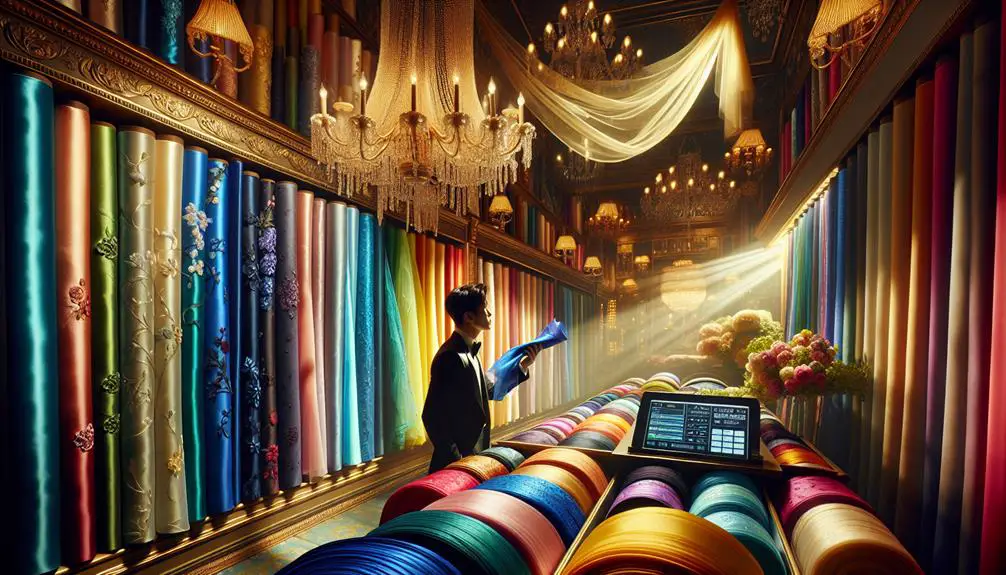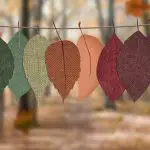When I looked into how much organza costs, I found it can be quite a range. Typically, you're looking anywhere from $1 to over $60 per yard. If you're going for basic polyester organza, it can be as cheap as $1 to $5 per yard, which is super affordable. But if you're after high-end silk organza, prices shoot up to $40 to over $60 per yard. The price really depends on the material and quality. Silk varieties tend to be pricier and look fancier. There's a lot more to consider that can affect the cost. You'll find out just how much these factors play a part as we go on.
Table of Contents
Key Takeaways
- Organza fabric prices range from $1 to over $60 per yard, depending on quality and type.
- Synthetic organza like polyester costs between $1 and $5 per yard, making it a budget-friendly option.
- Silk organza can cost between $10 and $60 per yard, with higher prices for premium qualities.
- Embellished organza, such as beaded or embroidered, starts at $20 per yard and can be more expensive.
- Prices can fluctuate based on seasonality, with higher costs in spring and early summer.
Understanding Organza Fabric
Organza fabric's sheer, lightweight nature makes it a popular choice for elegant garments and decor. I've always loved how it holds its shape, giving a touch of sophistication with its crisp texture. It's not just about looks; its durability is a big win. Despite its delicate appearance, organza is surprisingly strong, thanks to the tightly twisted fibers, typically silk or synthetic materials like polyester.
Handling organza can be tricky, though. It frays easily and can get staticky if you're not careful. When I work with it, I've to be extra gentle to avoid snags and tears. Sewing with organza requires patience and precision because any mistake shows up quite clearly due to its transparency.
Cleaning organza is another area where you need to tread carefully. It's generally best to dry clean it to maintain the texture and sheen. If you're tempted to wash it yourself, remember that water can sometimes leave marks on organza, so it's a risk.
In short, organza demands respect and careful handling, whether you're crafting a gown, a curtain, or adding a fancy touch to your decor. It's all worth it, though, for that stunning, airy elegance it brings.
Types of Organza Available
When I start looking at organza, I find there are mainly two types to consider: silk organza and synthetic.
Silk organza varieties are more luxurious and often pricier, as they're made from natural silk fibers.
On the other hand, synthetic options are usually more affordable and offer a similar sheer, crisp texture.
Silk Organza Varieties
Silk organza comes in several types, each with its unique texture and quality.
First, there's plain silk organza, lightweight and slightly stiff, perfect for bridal wear and evening gowns. It's got a subtle sheen that looks elegant under the lights.
Then there's crystal silk organza, which is a bit more transparent and has a crisper feel, making it a go-to for designers looking to add volume without weight.
For something with a bit of sparkle, mirror organza is infused with tiny reflective pieces that catch the light beautifully. It's ideal for those statement pieces.
Lastly, shot silk organza offers a two-tone look, woven from two different colored threads. It's fantastic for adding depth and interest to an outfit.
Synthetic Organza Options
Moving on from natural silk, let's dive into the world of synthetic organza options, which are both versatile and cost-effective. Synthetic organza is primarily made from polyester or nylon, making it a more affordable alternative to silk organza. It's super popular for its durability and ease of maintenance. You don't have to worry about it deteriorating as quickly as silk. Plus, it holds shapes and ruffles beautifully, perfect for those poufy dresses and structured decorations.
What's great is it comes in a wide variety of colors and patterns, since synthetic fibers are easier to dye and print on. This means you've got more creative freedom without breaking the bank. Ideal for anyone stepping into design work or event planning!
Average Price Range
Let's dive into the average price range of organza, which typically varies depending on quality and source. When you're looking to buy organza, you can generally expect to pay anywhere from $5 to $30 per yard. Now, you might wonder why there's such a broad range. Well, it mainly reflects the diversity in organza fabrics available.
At the lower end of the spectrum, around $5 to $10 per yard, you'll find basic organza. This type is often synthetic, made from polyester, and it's quite common for crafting and simple decor. It's pretty, it does the job, but it's not the top-tier stuff.
Moving up a bit, from $10 to $20, the organza you encounter usually has finer threads and a more luxurious feel. This range is often where you start seeing blends, perhaps with silk, which gives the fabric a gorgeous sheen and a softer texture.
Then, at the high end, from $20 to $30 per yard, you're looking at high-quality silk organza. This type is the cream of the crop, used in high fashion and elegant decor. It's super fine and feels almost like a whisper against your skin. This is the go-to for anyone wanting to make a real splash with their fabric choice.
Factors Influencing Cost
Several factors drive the cost of organza, from the type of fibers used to the complexity of the weaving process. Let me break it down for you.
First off, the materials themselves play a big role. You've got options like silk, polyester, or nylon, and each comes with its own price tag. Silk, being natural, often tops the chart in cost.
Next up is the production technique. Handmade organza? It's gonna cost you more than the machine-made stuff. There's a lot of skill and time involved in those traditional methods, and that bumps up the price.
Don't forget about the finishings and treatments applied to the fabric. Want something water-resistant or with a special sheen? Those extras aren't free and they add to the final cost. Plus, if the organza is adorned with embroidery or other embellishments, prepare to pay a premium.
Lastly, where it's made also matters. Fabric from renowned textile regions often carries a higher price due to their reputation for quality.
Price Comparison by Type
Now, let's look at how the prices vary among different types of organza.
Silk organza is usually the priciest option, while polyester organza tends to be more affordable.
If you're eyeing something fancier, embellished organza will cost you a bit more due to its added details.
Silk Organza Pricing
Silk organza prices vary depending on the type and quality. When you're out shopping, it's crucial to understand why there's such a price range. Here's a quick breakdown:
- Basic Silk Organza: This is your entry-level option. It's pretty, does the job, but isn't anything too fancy. You'll find it for about $10 to $20 per yard.
- Mid-Quality Silk Organza: A step up, this type has a nicer sheen and feels softer. Prices usually run from $20 to $40 per yard.
- High-End Silk Organza: Now we're talking top-notch material, often used in designer garments. It's luxurious and costs anywhere from $40 to over $60 per yard.
Keep these in mind, and you'll make a savvy choice!
Polyester Organza Costs
Let's dive into the costs of polyester organza, which can vary just as much as silk, depending on the quality and finish. Generally, you'll find polyester organza to be more wallet-friendly than silk. Prices typically range from about $1 to $5 per yard. The reason for this price variation? It largely comes down to the thickness and texture of the fabric. Thinner, more transparent types are usually cheaper, while thicker, sturdier versions cost a bit more.
When you're comparing types, pay attention to the weight and sheen. These factors influence not only the price but also how your final project will look and feel. Always check the fabric specifics to ensure you're getting the best bang for your buck.
Embellished Organza Rates
While polyester organza offers a more budget-friendly choice, the rates for embellished organza can vary significantly based on the type and extent of embellishment. When you're looking to buy, you'll notice the price points shoot up with the complexity and quality of the work done on the fabric.
- Beaded Organza: Starting around $30 per yard, especially if it's got intricate hand-sewn beads.
- Embroidered Organza: Prices often begin at $25 per yard, climbing higher with more detailed designs.
- Sequined Organza: This type can start at $20 per yard, but expect to pay more for denser, more elaborate patterns.
Seasonal Price Variations
Organza prices often fluctuate with the changing seasons, hitting their peak around spring and early summer. It's all about supply and demand. During these months, there's a surge in weddings and graduations—events that just love the light, airy feel of organza. This increased demand can drive prices up, so if you're planning something special, it pays to think ahead.
On the flip side, in the fall and winter, you might notice that organza gets a bit cheaper. It's less in demand, and stores want to move their stock. This is a great time to snag some deals, especially after the holiday frenzy when retailers are looking to clear out inventory and prepare for new spring collections.
Buying Organza in Bulk
Buying organza in bulk can save you a lot of money, especially if you're planning a big event. When you purchase large quantities, suppliers often offer a discount, which can be vital in managing your budget effectively. I've found that buying in bulk also reduces the stress of last-minute shopping for additional fabric.
Here are a few things I consider when buying organza in bulk:
- Quantity Needs: I estimate how much material I'll actually need, considering the scope of my project or event. It's crucial not to overestimate as this could lead to unnecessary costs.
- Storage Capability: Before making a bulk purchase, I ensure I've adequate space to store the fabric. Organza is delicate and should be kept away from moisture and dust.
- Color Consistency: Buying in bulk ensures that all the fabric comes from the same dye lot, which means there's no risk of color variation across different pieces.
I make sure to communicate clearly with the supplier about my specific needs. This includes the exact shade, fabric quality, and the time frame for delivery. It's all about balancing cost-effectiveness with project requirements.
Tips for Finding Deals
After covering how to save on bulk purchases, let's look at some strategies to find the best deals on organza.
First off, I always compare prices online. It's a no-brainer, but you'd be surprised how much the cost can vary between different retailers. I use price comparison tools to quickly see where the best deals are at the moment.
Next up, don't ignore the power of coupons and discount codes. I sign up for newsletters from fabric stores because they often send out exclusive deals to their subscribers. It's also worth checking out major coupon websites before making a purchase.
Another tip is to shop during sales events. Black Friday, Cyber Monday, and end-of-season sales are prime times to snag organza at a lower price. I keep a list of what I need and wait for these times to buy.
Lastly, I've found that sometimes local fabric shops offer better deals than online giants, especially if you develop a relationship with the shop owners. They sometimes give a heads-up about upcoming sales or even set aside some fabric at a discount for regular customers.
Organza Vs. Other Fabrics
When comparing organza to other fabrics, it's all about the feel and toughness.
Let's look at how the costs stack up and where these fabrics typically show up.
We'll see why organza might be your go-to or when another fabric could be a better choice.
Texture and Durability Differences
Organza's crisp and sheer texture sets it apart from more opaque and heavier fabrics like cotton or wool. This light and airy fabric adds a delicate touch that's perfect for evening wear or fancy drapes, but it's not just about looks.
Let's break down how it stacks up in terms of texture and durability:
- Sheerness: Organza is much more transparent than many other fabrics, which lends itself to layering in designs for added depth without bulk.
- Weight: It's incredibly lightweight compared to denser materials like denim or tweed, making it ideal for fuller garments that require a lot of fabric without being too heavy.
- Durability: Despite its delicate appearance, organza is surprisingly strong and resistant to tears, thanks to its tight weave. However, it can snag more easily than some thicker fabrics.
Cost Comparison Overview
Let's dive into how the cost of organza compares with other popular fabrics. Generally, organza is a bit pricier than your everyday cotton or polyester. That's because it's often silk-based, which already ramps up the price.
But when you compare it to luxury fabrics like silk itself or fine lace, organza is actually kind of a middle-of-the-road option. It's more affordable than these high-end materials but offers a touch of elegance that you won't get from cheaper textiles.
If you're eyeing something with a bit of sheen and decent durability without breaking the bank, organza is a smart pick. It balances cost and class pretty well, making it a popular choice for those who want a luxe vibe on a budget.
Common Usage Scenarios
Organza often steals the spotlight in bridal gowns and evening wear, where its sheer, lightweight texture contrasts sharply with heavier materials like velvet or brocade. I've noticed that when you compare organza to other fabrics, it really shines in a few specific scenarios:
- Wedding Dresses: The crisp yet delicate appearance of organza adds a magical touch to wedding dresses, making them appear both elegant and ethereal.
- Home Decor: It's not just for clothing—I've used organza for lightweight curtains and as accents on decorative pillows. It catches the light beautifully, adding a subtle shimmer.
- Fashion Accessories: Organza makes fantastic scarves, ribbons, and even flower pins. Its stiffness allows for voluminous yet refined bows and embellishments.
These uses really highlight its versatility and unique charm.
Maintenance and Longevity Costs
Caring for organza can rack up costs over time, especially if you're aiming to keep it looking its best. This delicate fabric requires gentle handling to maintain its crisp and elegant appearance. Regular dry cleaning is often recommended to keep organza items fresh and vibrant, but this can quickly become pricey. Each trip to the dry cleaners might cost you, depending on your location and the cleaner's rates.
Beyond cleaning, there's also the matter of storage. Organza is prone to wrinkles and should ideally be hung in a spacious area to prevent creasing. Investing in good quality hangers and possibly a dedicated storage space is essential but adds to the overall cost. You might also consider using garment bags to protect your organza clothes from dust and moths, which means another addition to your maintenance budget.
Finally, repairs are another cost factor. Due to its fine threads, organza is susceptible to tears and snags. Fixing these issues usually requires a skilled hand, and professional seamstresses don't come cheap.
All these factors mean that while organza mightn't break the bank at purchase, its upkeep certainly can add up, impacting its overall cost-effectiveness in your wardrobe.
Where to Purchase Organza
After considering the upkeep costs, you might wonder where you can buy organza fabric. I've got you covered! Here are some top spots where I've had great experiences shopping for organza:
- Local Fabric Stores: Check out your nearest fabric shop. They often have a variety of organza types, from sheer to embroidered. Plus, you get the chance to feel the texture and see the exact colors, which is super handy if you're matching shades for a specific project.
- Online Retailers: Websites like Fabric.com or Mood Fabrics are my go-to's for buying fabrics online. They offer extensive selections and user reviews, which can be incredibly helpful. You'll find everything from budget options to designer organza. Just make sure to check the return policy, in case what you get isn't quite what you expected.
- Craft Chains: Stores like Joann's or Michaels often stock organza, especially around the holiday season when it's used for decorations and gift wrapping. They also frequently offer coupons, which can save you some cash if you're buying in bulk.
No matter where you choose to shop, remember to check the width and quality of the organza to ensure it meets your project needs!
Frequently Asked Questions
Can Organza Fabric Be Dyed at Home?
Yes, I can dye organza fabric at home using acid dyes and vinegar to set the color. It's a simple process, but I'll need to handle the fabric gently to avoid damage.
Is Organza Suitable for Outdoor Events?
Organza's airy charm isn't ideal for outdoor events; it's too delicate. I've found it easily wrinkles and doesn't handle moisture well, making it a risky choice for any exposed setting.
How Does Organza Impact the Environment?
I've found that organza's environmental impact varies. It's often made from silk or synthetic fibers, which means its production can be resource-intensive and contribute to pollution, depending on the manufacturing processes used.
Are There Hypoallergenic Options for Organza?
Yes, there are hypoallergenic organza options available! They're made from silk or synthetic fibers that reduce allergic reactions. I've found them perfect for sensitive skin, ensuring comfort without sacrificing style.
Does Organza Offer UV Protection?
I've looked into it, and organza doesn't offer UV protection. It's too sheer and lightweight, so if you're looking for something to shield you from the sun, you'll need a different fabric.
- Chino: Fabric or Style? Understanding the Difference - June 20, 2025
- Is Chino a Fabric? Understanding Chino Material - June 20, 2025
- How to Order Fabric From China: Tips and Tricks - June 20, 2025







